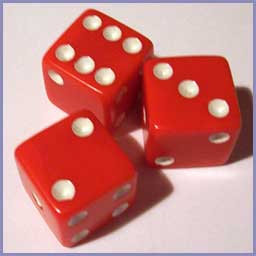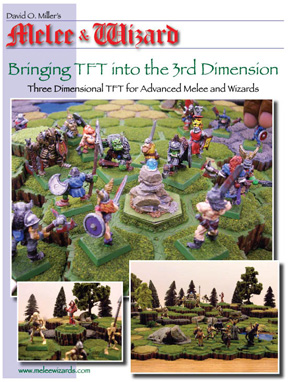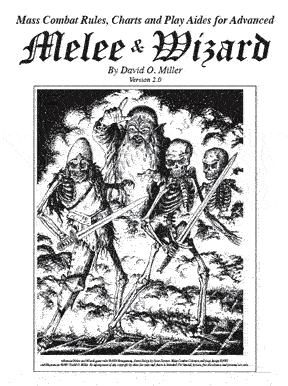

The rules for Melee & Wizards are simple and playable yet extremely adaptable to cover a broad range of situations. That's the beauty of them. Personally I feel that because Metagaming went out of business the gaming community was not submitted to book after book of rules additions ad nauseam just to make additional income for the company. What we have is a core set of rules that work extremely well. And in my experience simplicity equals enjoyability.
The original, basic rules can be currently found at:
http://bluwiki.com/go/Tft-melee
http://bluwiki.com/go/Tft-wizard
There is a TFT tribute web site that offers pdf downloads of all of the Advanced rule books and scenarios. Because the copyright status of the material is still in question you will have to send a statement of intent to the author of the site declaring that you own a legally acquired copy of the original published game. After that you will be able to download the files. Here's the web site: http://gettft.brainiac.com/
Dark City Games also has a set of rules compatible with TFT called "Legends of the Ancient World". You can download a pdf copy of these rules by clicking here: Legends Rules Download
But this doesn't mean that many have not come up with their own wonderful additions and house rules to the official cannon. I'm a purist at heart, you'll find very few of these types of rules here. Where I have made small alterations to the rules I have always tried to keep it simple and in the spirit of the original rules. I am also including reorganized charts that, in my opinion, make the game easier to play.

Bringing TFT into the 3rd Dimension!
The Milton Bradley game “Heroscape” comes complete with a large supply of 3 dimensional, interlocking hex tiles that are perfect to play TFT with. By combining these tiles in different ways you can create endlessly variable terrain. Unfortunately, bringing Melee into the 3rd dimension presents problems that the original rules did not cover or even anticipate. This is my attempt at a set of “house rules” that captures both the simplicity and the playability of the original TFT rules while allowing one to enjoy the tactical situations that the added dimension of height brings. At first glance they may appear complicated but after you understand them they are very easy to play.
Click here to go to the TFT 3rd Dimension download page.

Combat Rules, Charts and Play Aides
For many years I have enjoyed some of my best games of Melee/Wizards when it is played not as a role-playing game but as a large scale, skirmish combat game. Over the years my various gaming groups have fine tuned the way we choose and create characters, how we equip them, and even the character sheets to record them on, all to make game play easier. I'm offering those rules here for you to download. You'll find 14 pages of charts, rules options and character sheets, both for fighters and wizards. You'll also find new rules variants to make playing large combats easier as well as a list of character types and the rules to create them so each team has the same amount of points. If you've never tried Melee/Wizards this way you should give it a shot. Before you know it you'll have 7 hex dragons battling trolls and giants while great strength characters go into battle wielding two greatswords one handed! It's Melee like you've never played it before!
Click here to go to the Large Combat Rules, Charts and Play Aides page.
House Rules
• Wizards ST: Wizards ST is broken into Normal ST and Magical ST. Normal ST is used to record wounds against while Magical ST is used to cast spells. I know doing this has it’s advantages and disadvantages but the main advantage is to keep a wizard who has cast all but one of his ST points from being killed by a simple wound that does only a few points of damage. I never liked the idea that casting a spell somehow hurts a wizard or causes so much fatigue that a simple wound will kill him. This solution (while not ideal) works well enough during regular play.
• ST as Damage to Wizard: Another idea concerning Wizards ST is that after a Wizard is completely out of Magical ST he (or she) can continue casting spells but at a considerable, physical strain. After depleting the normal Magical ST the Wizard becomes fatigued. To continue casting spells at this point physically hurts the Wizard. To represent this let the Wizard mark off two Normal ST hits as internal wounds to gain one point of Magical ST to power spells. This basicaly doubles the cost of all spells. I liken it to an emergency situation where a Wizard starts giving up some of himself to manipulate the powers that produce magic. Makes for great role playing moments as well.
• Pole weapons: This is the biggest alteration I’ve made. After many years of playing Melee by the rules I have finally succumbed to altering the pole weapon charge attack rules. Many people I have played with have adopted the “move three hexes in a straight line” to define a charge attack but that always seemed to take away from some of the strategy of the game. Force Retreats are much more important if you can force your opponent back one hex and then do a charge attack the following round. The charge three hexes in a straight line rule weakens or negates the need for the Force Retreat. I also found that I had to start limiting the number of pole weapons available to a group simply because players started arming everyone with these high damage weapons and ignoring the other weapons.
After many years of tinkering with these rules I final realized it was not the movement that I had a problem with but the amount of damage that the weapons were capable of doing. A 2+2 pike axe in a double damage charge attack can max out at a whopping 28 points of damage. (A 3+1 two handed great sword is only capable of a total of 19 points.) But I didn’t want to severely limit what the smaller pole weapons could do damage wise. I still wanted goblins armed with one handed spears to be somewhat dangerous. I finally came to understand that the big problem I had was with the top two weapons, the Halbred and the Pike Axe. My solution was to have pole weapons in a charge attack do an extra D6 worth of damage instead of the double damage that the original rules call for. If you look at the pole weapons chart this system still allows the smaller weapons to (basically) do double damage in a charge attack but slightly lowers the damage of the two bigger weapons, making them less devastating.
Here are the smaller weapons listed with normal damage and charge attack damage: Javelin (1-1) does 2-1 in a charge attack, Trident (1) does 2, 1H Spear (1) does 2, 2H Spear (1+1) does 2+1. In all cases you are “pretty much” doing double damage.
Here are the larger weapons listed with normal damage and charge attack damage: 2H Halbred (2) does 3 in a charge attack, 2H Pike Axe (2+2) does 3+2, Lance (3-1) does 4-1. As you can see the charge attack damage is no longer as devastating as originally written and I’ve still managed to keep the lance pretty formidable.
• Reactions to Injuries: In combats involving large numbers of figures I simplify reactions to injuries. It’s hard to keep track of how much damage a single figure has taken in a turn when you’re dealing with, say 25 figures. To solve this problem I play that it takes 5 points of damage “in one blow” to cause a -2 DX the following turn and it takes 8 points of damage “in one blow” to cause a human size figure to fall down.
• Unconsciousness: Most the time, when I play Melee, it's a fight to the death, not a fight to unconsciousness. Figures with 1, 2, or 3 ST remaining of course are at a -3 DX due to their injuries.
• Bow vs. Pole Weapons in a Charge Attack: If a pole weapon charge attacks a bowman and the bowman has a higher DX then the bowman gets the shot off before the pole weapon gets to attack. This is just a logical continuation of the pole weapon goes first because it’s longer rule in the original game.

Terrain • Play Aides • Rules • Hex Sheets • History
Game Photos • Scenarios • Links • Miniatures
Click here to return to the home page • Visit my Web site at: davidomiller.com
